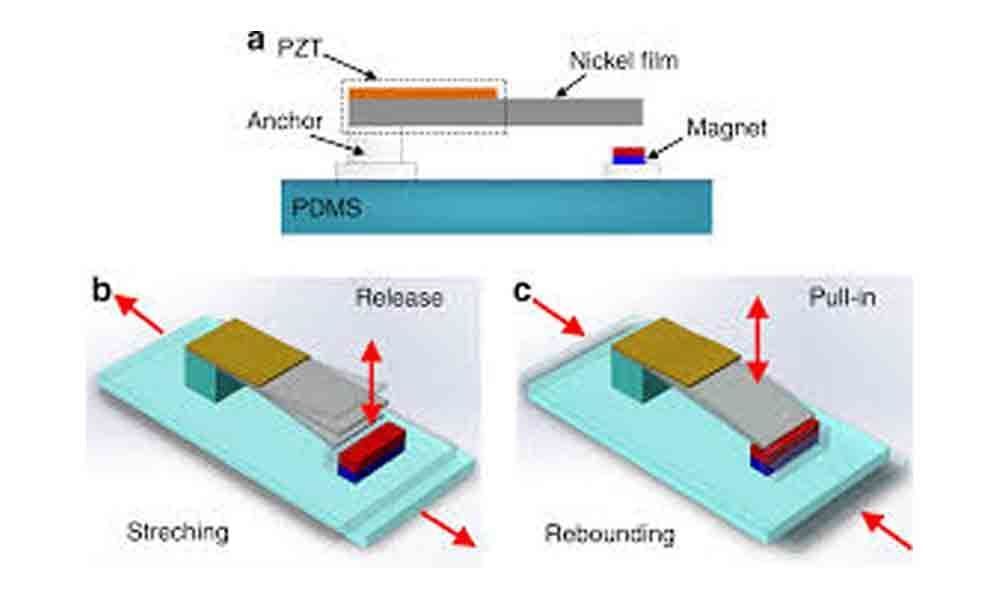Live
- 40 elephants, 5 leopards died in 5 months: Minister
- ECoR felicitates 3 employees for alertness
- Constitution has given equal rights to all: CM
- Two officials held for collecting money from trucks on NH
- Majhi bats for disaster-resistant infra
- Grand Celebration of Constitution Day at District Police Office
- Constitution Day and National Law Day Celebrated with Enthusiasm at Gadwal PG Center
- Constitution Day Celebrated in Aija: Leaders Highlight Ambedkar’s Vision and Fundamental Rights
- Gadwal BJP Celebrates 75th Anniversary of Indian Constitution with Floral Tributes to Dr. B.R. Ambedkar
- Seal of authenticity for JK crafts by WCC soon
Just In

Scientists have created a flexible material that can harvest energy from body movements to power wearable devices and sensors.
Scientists have created a flexible material that can harvest energy from body movements to power wearable devices and sensors.
Researchers from Rice University in the US adapted laser-induced graphene (LIG) into small, metal-free devices that generate electricity. Like rubbing a balloon on hair, putting LIG composites in contact with other surfaces produces static electricity that can be used to power devices, they said.
According to the research published in the journal ACS Nano, the triboelectric effect helps materials gather a charge through contact. When they are put together and then pulled apart, surface charges build up that can be channelled toward power generation. In experiments, the researchers connected a folded strip of LIG to a string of light-emitting diodes and found that tapping the strip produced enough energy to make them flash.
A larger piece of LIG embedded within a flip-flop let a wearer generate energy with every step, as the graphene composite's repeated contact with skin produced a current to charge a small capacitor. "This could be a way to recharge small devices just by using the excess energy of heel strikes during walking, or swinging arm movements against the torso," said James Tour, from Rice University.
LIG is a graphene foam produced when chemicals are heated on the surface of a polymer or other material with a laser, leaving only interconnected flakes of two-dimensional carbon. The team first made LIG on common polyimide, but extended the technique to plants, food, treated paper and wood. The researchers turned polyimide, cork and other materials into LIG electrodes to see how well they produced energy and stood up to wear and tear.
They got the best results from materials on the opposite ends of the triboelectric series, which quantifies their ability to generate static charge by contact electrification. In the folding configuration, LIG from the tribo-negative polyimide was sprayed with a protecting coating of polyurethane, which also served as a tribo-positive material. When the electrodes were brought together, electrons transferred to the polyimide from the polyurethane.
Subsequent contact and separation drove charges that could be stored through an external circuit to rebalance the built-up static charge. The folding LIG generated about one kilovolt, and remained stable after 5,000 bending cycles. The best configuration, with electrodes of the polyimide-LIG composite and aluminum, produced voltages above 3.5 kilovolts with a peak power of more than 8 eight milliwatts.
"The nanogenerator embedded within a flip-flop was able to store 0.22 millijoules of electrical energy on a capacitor after a one-kilometre walk," said Michael Stanford, postdoctoral researcher at Rice University. "This rate of energy storage is enough to power wearable sensors and electronics with human movement," Stanford said.

© 2024 Hyderabad Media House Limited/The Hans India. All rights reserved. Powered by hocalwire.com







